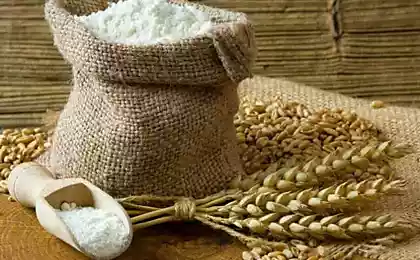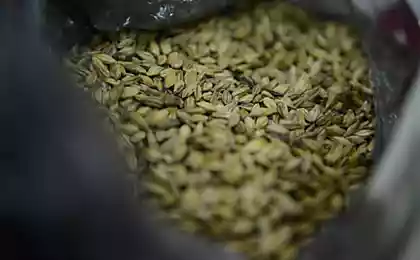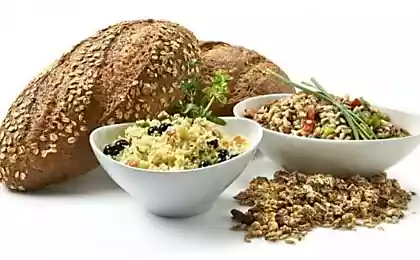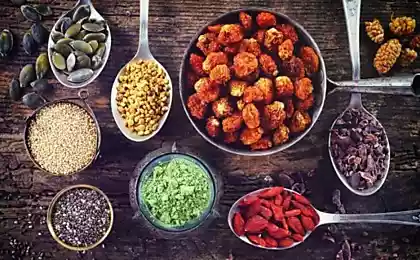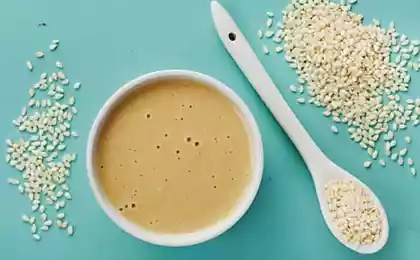734
What flour is the most useful

Flour grades differ in the output, that is, the amount of flour obtained from 100 kg of grain, color, and various degrees of milling, content otrublennyh particles, the amount of gluten and ash content.
Thus, the flour in the production process thoroughly cleaned from grain shells. Because of this, it does not contain gluten, as well as magnesium, potassium and b vitamins It is used, for example, for baking muffins, as well as thickeners for a variety of sauces — that is, for products that cannot be called fitnessbike.
First grade flour is processed so that it maintains a high gluten content. In addition, it is rich in phosphorus and calcium. By the way, products of this kind of flour is slower to harden.
But flour is ground along with the shell of the grain. So in this very "lame" flour usually contains up to 8% of bran and fully preserved all of the vitamins and minerals contained in cereals. Flour not suitable for baking or cakes, but it can cook pancakes and dumplings.
Wholemeal flour is made of all kinds of soft wheat and contains the highest amount of bran (twice as much as flour). Although this variety is significantly inferior in terms of bakery flour of second grade, it has more vitamins and various trace elements. For example, in the grain shell contains proteins, vitamins b and E, minerals calcium, phosphorus, iron and magnesium. And the core of the grain is rich in starch. The ideal application for this flour — bread baking.
Baking bread in the shops you can find special bread flour. Its fundamental difference from other types of flour — high protein content (11,5—13,5%) which form gluten and the crust. Sometimes to expedite the fermentation of dough in this type of flour can be added to the malt flour.
Gaining popularity and flour. In its production of grain is not clear from either of the outer layers of the endosperm or embryo or from the shell. Consequently, this meal in full contains dietary fiber, vitamins B1, B2, E, PP, unsaturated fatty acids, amino acids, sucrose, protein, hemicellulose, selenium, chromium, fluorine, calcium, copper, zinc, potassium, magnesium. In other words, this meal is useful even for those who are dieting and aim to lose weight.
Types and use Kind of flour is determined by the culture from which it is made. In addition, the flour can be from one culture and from a mixture of different grain crops. IMPORTANT: the shelf life of natural (no added stabilizers and baking powder) flour is from 3 to 6 months maximum, depending on the species and variety.
Wheat flour remains the most popular. It is as solid and soft wheat varieties. Application: from soft wheat — suitable for bread and pastries, and hard — to pasta and pizza. In addition, it can replace bread crumbs.
Rye flour was used for baking of bread, is now used more widely. Is Wallpaper paste, flour (contains less grain shells), seeded (no fragments of shells and other particles of the grain), and special (negociando). Application: baking, rye bread, cookies, pancakes, fritters, pies, cakes. In order that the cakes came out good, the rye flour is mixed with high-grade wheat flour.

Oatmeal contains easily digestible carbs and promotes the production of the hormone serotonin. Amino acid composition of oats is very similar to muscle protein. Oatmeal also contains vitamins A, E, b group, micro - and macronutrients, fiber, quite a lot of fat and dietary fibre, but low starch. Application: oat flour makes the cakes more airy and crumbly. This kind of flour can also be added to casseroles and cereal. But it is worth remembering that due to its low content of gluten-free oat flour in your baking should be no more than one third of the total amount of flour.
Rice flour is different in that it does not contain gluten. At the same time, it contains many different minerals and vitamins, and starch. Application: baking bread and crispy tortillas; rice flour can be used as a thickener for soups and sauces. The only caveat — you must use a quarter of the quantity of other flour (or one-fifth, when baking bread), and add a little more water.
Pea flour is considered a valuable dietary product. It is rich in fiber, Pantothenic acid, vitamins A and C, and minerals (magnesium, zinc, potassium, calcium, phosphorus and iron) and amino acids. The content and quality of useful protein pea flour is not inferior to even some varieties of meat, while there is absolutely no cholesterol. A high content of selenium may even protect the body from carcinogens. Application: bread baking, cakes, cookies, donuts, cooking pasta, and vegetable cutlets.
Barley flour contains beta-glucan, which lowers cholesterol, protecting our blood vessels and heart. This type of flour comes in two varieties — wholemeal or seeded. Moreover, the Wallpaper almost always whole-wheat and in the production of seed removed bran (the shell of the grain). Application: tasty and healthy pancakes.

Buckwheat flour is considered a dietary. Is it as Wallpaper and there is only one variety. Application: breads, cakes, pancakes, dumplings. It can also be added to omelets and casseroles, or used as a breading, such as for cutlets.
Flax flour is rich in dietary fiber, polyunsaturated fatty acids (omega-3 and omega-6), vegetable protein, vitamins B1, B2, B6, folic acid, antioxidants (lignans) as well as potassium, calcium, magnesium, zinc, and other nutrients. Flaxseed and protein for their balanced amino acid composition of protein is superior to many cereals and legumes. Application: baking biscuits and rolls, can be used in the test instead of eggs, as breading for meat and fish, add to omelets, soups, salads and casseroles.
As you can see, the flour really is different. Moreover, the criteria considered to be indicators of high quality, actually useful are not. But this does not mean that the flour should completely abandon. You just need to choose healthier varieties and to limit in your diet the consumption of wheat flour. published
Source: fitfixed.com

